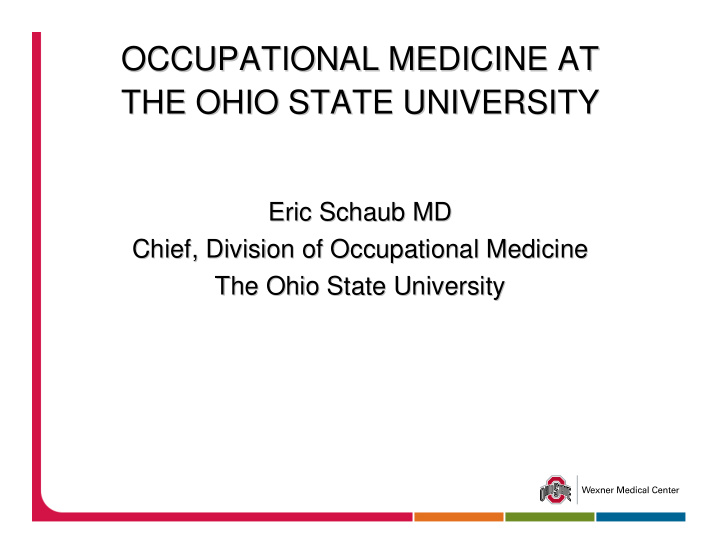



OCCUPATIONAL MEDICINE AT OCCUPATIONAL MEDICINE AT THE OHIO STATE UNIVERSITY THE OHIO STATE UNIVERSITY Eric Schaub MD Eric Schaub MD Chief, Division of Occupational Medicine Chief, Division of Occupational Medicine The Ohio State University The Ohio State University
Occupational Medicine Perspective Why focus on work related injuries? Discuss the interaction between work-related and non work-related conditions Work related back pain evaluation Diagnosis under BWC Expected time course Evaluation of work ability Vocational rehabilitation Maximum medical improvement Disability
Work Injuries and Primary Care In a national sample of ambulatory work injury care, Family Medicine provided 22% of care for work injuries, second only to Orthopedics (37%) Internal Medicine 8.9% Occupational Medicine 7.5% Represent 2.5% of all visits to Family Medicine Most visits were acute (55.3%) and for musculoskeletal conditions (46.5%) Won and Dembe, Annals of Family Medicine 2006
Work and Non-work related Interactions Traditionally work and non-work related risk factors and conditions have been dealt with as separate entities Payment issues Liability issues Epidemiology has dealt with single risk factors with other risk factors as confounders (“nuisance”) Organizations and society are now starting to consider disability costs and worker retention Schulte et al, AJPH 2012
Work and Non-work Interactions Age WRMSD Occupation Age Physical job demands Injury Age and occupation are both risk factors for work related musculoskeletal disorders Age is not synonymous with disease although linked to risk Retirement ages (as a society) are being evaluated due to financial burden of retirees (dependency ratio) Schulte et al, AJPH 2012
Work and Non-work related interactions Genetics Smoking and occupation Shift work Professions Medications Statins and sprains/strains/dislocations Fluoroquinolones and tendinopathy NSAIDs/WRMSD and adverse effects of NSAIDs Schulte et al, AJPH 2012; Khaliq and Zhanil, Clin Inf Dis 2003; Mansi et al JAMA Intern Med 2013
Worker’s Compensation in the State of Ohio Diagnosis driven ICD code Assigned at initial visit (ED, PCP, Occ Med) Additional ICD codes – have to be formally added Reasonable medical probability Related to the work injury Direct causation Substantial aggravation Flow-through Temporal association does not equal causation
Work related low back pain Diagnosis under BWC Diagnosis, not symptoms Supporting information Lumbar/lumbosacral strain Lumbar radiculopathy Spondylosis/spondylolisthesis/lumbar stenosis
Time Course Sprain/strain – 8 to 12 weeks Other medical conditions Depends on diagnosis and treatment Claim inactivation – 12 months Settlement of claim
Evaluation of work ability History Usual activities “Typical” tolerances Physical therapy (history and notes) Functional capacity evaluation (FCE) Therapist monitors physiologic measures and stops if there is risk of injury Self limitation
Vocational Rehabilitation Work conditioning/hardening FCE Gradual return to work Job search skills Living maintenance payments Bureau of Vocational Rehabilitation
Maximum Medical Improvement “Treatment plateau at which no fundamental change is expected in spite of medical treatment” Treatment is permitted Supportive, not resorative Temporary total disability is stopped Different than permanent total disability (PTD)
Disability Definition varies Gainfully employable (BWC) Meets predefined criteria (SSDI) Able to return to former position of employment Disabled under one definition and not disabled under another definition
Summary More attention to interaction of work and non- work interactions Be aware of diagnosis – work related, formally added Address work ability at every visit Be aware when a referral needs to be made for vocational rehabilitation Issues to consider include MMI and disability/ability
eric.schaub@osumc.edu Questions?
Recommend
More recommend